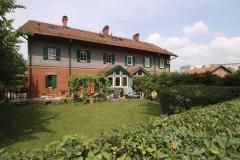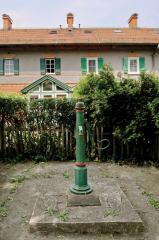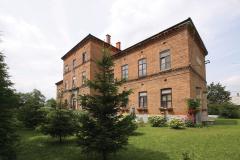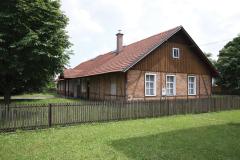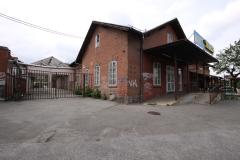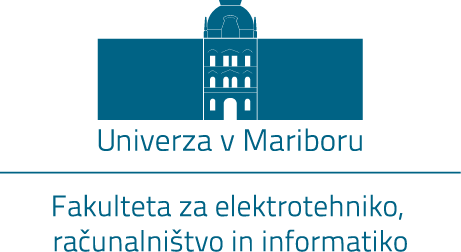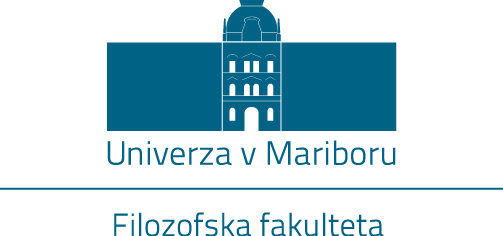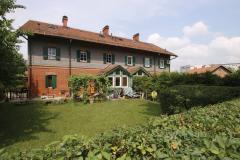
The Railway Colony
Location: in between Gorkega ulica, Koresova ulica, Murkova ulica and the former Koroška railway station
Architect: Gustav Heinrich Flattich
Time of construction: 1863-1874
In 1846, the Southern Railway of the Vienna-Trieste route reached Maribor. All cities along the railroad thrived economically, since it was the biggest infrastructural project in the Austro-Hungarian Monarchy. Maribor had an especially important role in this project; on the right riverbank of the Drava River, a branch was joined to the Southern Railway, which split off towards Carinthia. Furthermore, in 1863 they set up large railway workshops in its vicinity. This was the first large industrial complex in Maribor, which covered the needs of the areas from Mürzuschlag to Trieste and from Lienz to Sisak. In its first year there were already a few hundred workers employed in the railway workshops; in 1869 there were 825 workers, in 1870 the number rose to 1070, while later it only increased. The employees mostly came from other places since, at least in the first period, there were no adequately educated workers in Maribor.
There was a shortage of suitable apartments for the railway workers, Maribor's new inhabitants. Consequently, in 1863 the Southern Railway Administration started building residential houses on the right riverbank of the Drava River, right on the doorstep of the railway workshops. The construction of apartment buildings for the workers initiated the first partial regulation plan for Maribor. This plan regulated any interventions in this part of Maribor in accordance with the railway workshops. First, twelve houses with four apartments each were built between today's Gorkega ulica, Ulica heroja Zidanška and Ghegova ulica. Two houses had one storey; the others had the ground floor with the attic converted into apartments. The houses are strung along from east to west. Today, most of them have been rebuilt, with some being unrecognizable in comparison to their original appearance. The locals call them "the old colony". By 1874, 28 longitudinal single-storey houses with eight apartments had been built in the area between Gorkega ulica, Ghegova ulica, Komenskega ulica, Murkova ulica and Koresova ulica. These buildings are larger and mostly retain their original appearance. The majority of the apartments strung along on both sides of the interior longitudinal corridors consisted of two rooms and a kitchen. At first, there was no plumbing inside the houses; however, there were twelve wells in the settlement. For washing, homemakers had at their disposal five large buckets filled with water from the Drava River. Today, each building is still surrounded with a garden and has a woodshed alongside it. In the old days, the residents were also allowed to breed small animals beside the houses. All of them, even the ones from "the old colony", are arranged in a regular raster with rectangular gardens; the streets between them intersect perpendicularly. The ground floors of the railway houses in Maribor are built with twice-burnt red bricks, while the upper storeys are plastered with grey paint and divided with sawtooth cornices. The façades of the school in the housing estate are also made of red brick with an avant-corps in the middle. The school is built in a Neo-Renaissance style; sawtooth cornices also divide the storeys of the school. Its interior is distinguished by a wide and bright two-flight staircase. The ground floor kindergarten in the immediate vicinity of the school showcases timber framing.
Towards the end of the 19th century, there were 368 apartments in the old and new colonies. Soon after moving in, around 1600 people resided there. Until the end of World War I, the residents of the railway colony had spoken mostly German. The colony was like a German island in the Maribor suburbs. In it, the residents had almost everything they needed for everyday life at their disposal. A kindergarten was built in 1870, a school in 1873, and a department store in 1874. They also had a swimming pool and a well-stocked library. The tenants' community ran several societies.
Southern Railway administration, the owner of the houses, was responsible for their maintenance; however, the railway workers and their families had to move out of the apartments three months after retirement at the latest. The managers took exemplary care of the houses up until the end of World War I, when the state became their new owner. After that, the maintenance began to decline. Recently, the attitude towards the buildings has begun to improve. In 1990, one of the houses was renovated as an example. The school and the kindergarten have long ago lost their original purposes; the school has been converted into apartments, the kindergarten into administration offices.
Viennese architect Gustav Wilhelm Flattich (1826-1900), who was the construction director of the Southern Railway Company (Südbahngesellschaft) planned the Maribor Railway Colony. Flattich is the architect of a number of buildings along the Southern Railway; the most renowned ones are the Southern train station in Vienna (1873), which was demolished during World War II, and the train station in Trieste (1878), which is still standing. He also planned the two-storey buildings with rental apartments for the railway workers in Vienna's XXII. district of Meidling (1870). Long buildings with brick façades and sawtooth cornices are strung along the street. Formally, they are similar to the houses in the Maribor Railway Colony.
Marjeta Ciglenečki
(29 September 2014)
